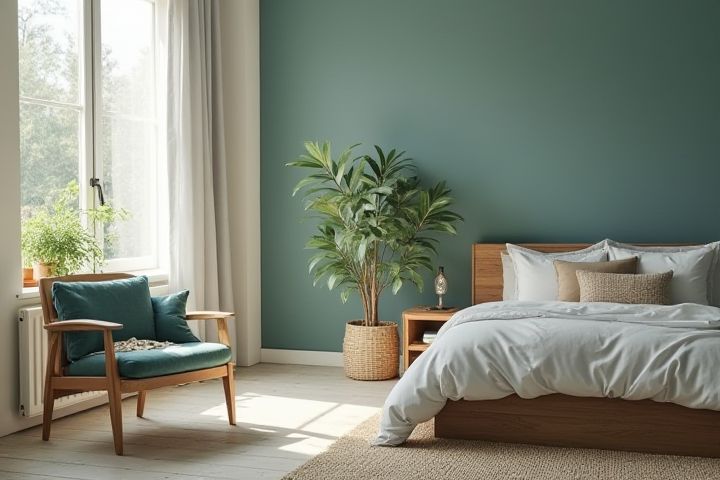
To keep your house cool during the summer, employ strategic window treatments like reflective shades or blackout curtains that block out heat from sunlight. Use ceiling fans and portable fans to enhance air circulation, allowing for more efficient cooling. Insulating your home with proper weatherstripping and insulation reduces heat infiltration, keeping indoor temperatures lower. Consider using energy-efficient appliances that generate less heat and installing programmable thermostats to optimize cooling schedules. Lastly, maintaining your HVAC system through regular maintenance ensures optimal functionality, providing a comfortable indoor environment despite rising outdoor temperatures.
How To Keep A House Cool In Summer
Use blackout curtains and blinds
Blackout curtains and blinds are effective tools for maintaining a cool indoor environment during summer months, reducing up to 25% of heat entering your home. These window treatments block sunlight, preventing heat buildup and helping to lower indoor temperatures. Look for curtains made from dense, reflective materials that provide maximum insulation against outside heat. Implementing blackout curtains and blinds in living spaces can significantly improve your comfort and reduce energy costs by decreasing the reliance on air conditioning.
Install ceiling fans
Installing ceiling fans can significantly improve air circulation and reduce reliance on air conditioning during summer months. With a range of styles and sizes available, you can find a fan that complements your home's decor while efficiently cooling your space. Generally, a ceiling fan can create a wind chill effect, making the temperature feel about 4 degrees Fahrenheit cooler. To maximize efficiency, be sure to run your ceiling fan counterclockwise in warmer months, which enhances airflow across your skin.
Optimize window placement for cross-ventilation
To effectively keep your house cool in the summer, optimize window placement to facilitate cross-ventilation. Strategically position windows across from each other to allow for a natural airflow, creating a refreshing breeze when winds are present. Additionally, consider adding awnings or using strategically placed trees to block direct sunlight, which helps maintain a cooler indoor temperature. Properly sized windows can enhance ventilation, ensuring that hot air exits and cooler air enters, making your living space more comfortable.
Use energy-efficient LED lighting
Using energy-efficient LED lighting can significantly reduce heat buildup in your house during the summer months. Unlike traditional incandescent bulbs, which emit up to 90% of their energy as heat, LED bulbs produce very little heat while providing the same level of brightness. By replacing 25 standard 60-watt incandescent bulbs with LED equivalents, you can save approximately $150 per year on energy costs and maintain a cooler indoor environment. This simple upgrade not only enhances your cooling efforts but also contributes to overall energy efficiency and cost savings.
Seal windows and doors for air leaks
To keep your house cool in summer, sealing windows and doors is essential for minimizing air leaks that allow warm air to infiltrate. Use weatherstripping or caulk to effectively seal gaps and cracks around your windows and doors, ensuring they are airtight. Regularly inspect these areas to identify any wear or deterioration that may compromise your cooling efforts. By preventing hot air from entering and cool air from escaping, you can maintain a comfortable indoor environment and reduce energy costs.
Use a programmable thermostat
A programmable thermostat is essential for maintaining a comfortable indoor temperature during the summer months. By setting specific temperature schedules, your home can remain cool when you need it most, while conserving energy during off-peak times. Optimize your settings by programming the thermostat to raise the temperature when you're away and cool it down shortly before you return. This not only enhances your comfort but also reduces energy costs, resulting in a more efficient household.
Plant shade trees around the house
Planting shade trees around your house can significantly reduce indoor temperatures during the hot summer months. Trees like oaks, maples, and willows can shade windows and roofs, blocking sunlight and lowering surrounding air temperatures by up to 25 degrees Fahrenheit. Strategic planting, ideally on the south and west sides, maximizes shading potential and minimizes direct sun exposure for your home. Maintaining a well-placed tree canopy not only enhances energy efficiency but also improves your outdoor living space and biodiversity in your area.
Apply reflective window film
Applying reflective window film is an effective method to keep your house cool during the summer months. This film reflects heat and UV rays while allowing natural light to enter, reducing indoor temperatures by up to 15 degrees Fahrenheit. Installing it on south and west-facing windows is particularly beneficial, as these areas receive the most direct sunlight. You can enhance your energy efficiency further by pairing it with other cooling strategies like using fans and maintaining proper insulation.
Avoid using heat-generating appliances during peak hours
Avoiding heat-generating appliances during peak hours, typically between 11 AM and 4 PM, can significantly lower indoor temperatures. Instead of using your oven, consider preparing no-cook meals or using appliances like slow cookers that generate less heat. By turning off high-energy devices such as dryers and dishwashers during these times, you reduce heat buildup and can maintain a cooler environment. You could also opt for energy-efficient lighting, like LED bulbs, which emit less heat and consume considerably less electricity.
Use dehumidifiers to reduce humidity levels
Using dehumidifiers can effectively reduce humidity levels in your home, making it feel cooler during the summer months. High humidity can result in uncomfortable temperatures, so maintaining indoor humidity between 30% and 50% is ideal for comfort. Dehumidifiers work by removing excess moisture from the air, which helps your air conditioning system operate more efficiently, potentially lowering your energy costs by 10-20%. To maximize effectiveness, consider placing dehumidifiers in high-humidity areas like basements or bathrooms, ensuring a comfortable living environment throughout your home.
